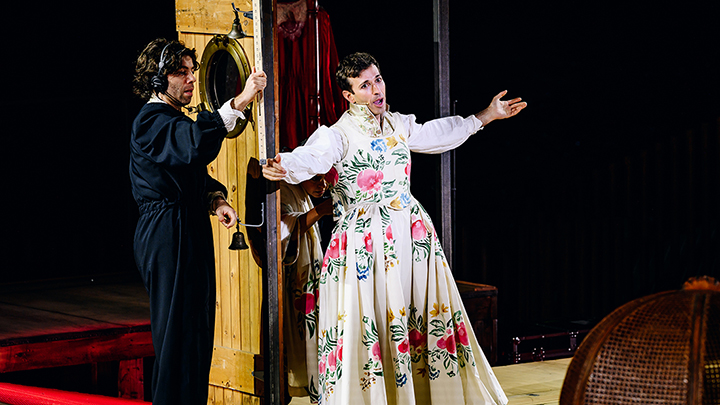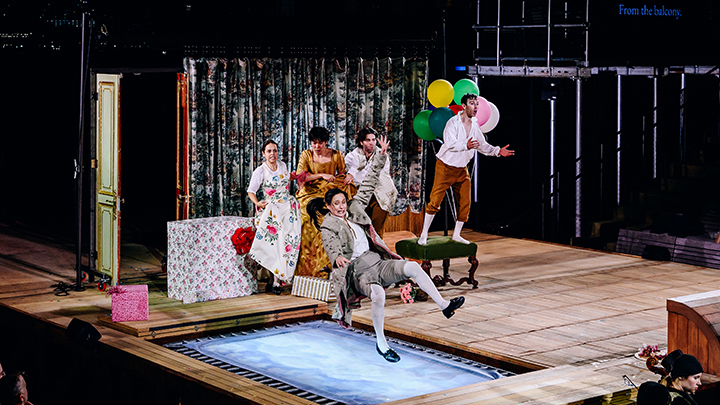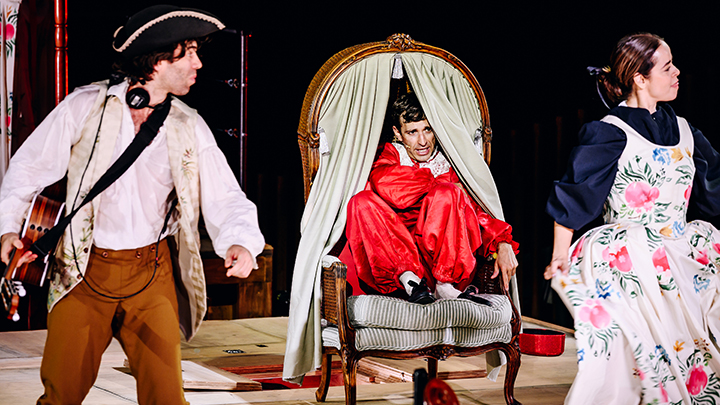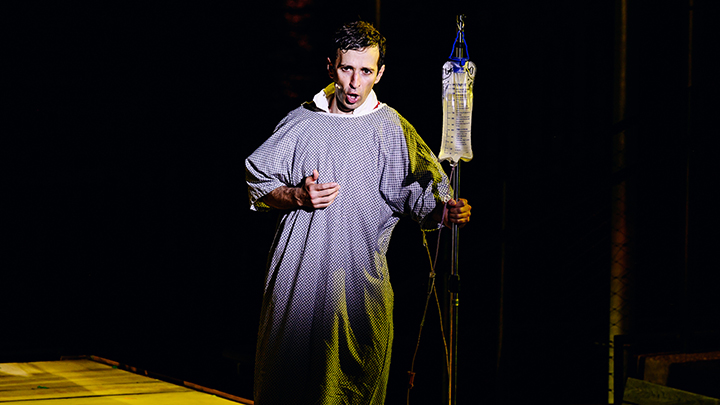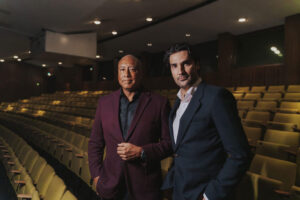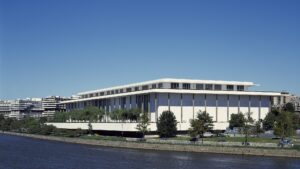The beautifully situated Amphitheater at Little Island, a striking manmade park jutting into the Hudson River near the southern entrance to the High Line, has been presenting performances all this summer. Its first season’s world premiere closing attraction, running through 22 September, is described on the venue’s website as “A new and radical take on Mozart’s classic about class and gender, all in one voice. Anthony Roth Costanzo plays every leading role in The Marriage of Figaro.”
The verb “is” was again heavily emphasized when Dan Schlosberg at the keyboard began leading his seven musicians in the whirling overture and the projected “movie titles” once again proclaimed that the peripatetic countertenor IS The Marriage of Figaro followed by photos of Costanzo as many (but not all) of Lorenzo da Ponte’s characters. This conceit, however, proved to be misleading as, though he sings (heavily amplified) virtually all of Schlosberg’s abridged edition of the score, he only “plays” Cherubino (and himself) for its final three-and-a-half acts.
But for the first 20 or so minutes, Dustin Wills’s antic production features Costanzo frantically embodying both Figaro and Susanna in their opening duets greatly aided by Emily Bode’s wittily velcro-ed costumes and several other speedy performers. After he plays both the Count and Don Basilio (aided by an annoying kazoo), energetic actors permanently take over as Susanna, the Count and soon Figaro and the Countess. Throughout the rest of the 110-minute running time, they suavely lip-sync while Costanzo finds hundreds of ways to not face the audience while singing his acres of music. He even tackles the many ensembles that dot the work, although he’s aided on several occasions by pre-recorded vocal tracks also, of course, featuring Costanzo.
The singer’s concept for this Figaro was apparently born decades ago when he was doing Cherubino (usually performed by a female mezzo soprano) and found himself singing through the entire score. After Little Island artistic director Zack Winokur mentioned to him, “We’re thinking of doing an opera, something everyone knows but nobody has heard,” gobs of money and time were thrown at putting Costanzo’s idea on stage. But pressing questions remains: Why? Who is this Figaro for? If audiences unfamiliar with Figaro (all Little Island tickets are budget-priced at just $25) were being targeted, why no synopsis or introduction to the concept in the digital program and why was show sung in Italian with two screens projecting the English translation?
In a “too little, too late” gesture, during the very awkward pause between the second and third acts, an actor raced through a long and windy précis in English of what we had just seen which then led (even more confusingly) to the performers playing Susanna and the Count campily performing a scene from the opera’s Beaumarchais source—in French!
For those intimately familiar with Mozart and da Ponte’s work, what, if anything, did the evening give us? Schlosberg has long been the music director of the wonderfully inventive Heartbeat Opera which presents challenging productions of classic works in abridged editions with reduced orchestrations. Although there were some awkward transitions (and the characters of Marcellina and Don Bartolo were omitted completely), he put together a brisk version of Figaro that struck me as more felicitous than the godawful one of Die Zauberflöte the Met trots out every December.
If the opera is indeed about “class and gender,” why was the evening (no updating here—it was all done in 18th century dress) completely toothless in presenting the long-simmering rage over class-iniquity that imbues both the original play and opera? Figaro does briefly touch on it in his long speech in English that also explains the unseen revelation about his paternity that Schlosberg’s edition omits. Although the Countess was played by man, the Count by a woman, no illuminating comments on gender were forthcoming.
Ultimately the evening came across as an extravagant, expensive, empty bow to Costanzo’s strutting versatility. Indeed, many aspects of his participation in the project were astonishing. During the swift exchanges during last-act finale, I marveled at his ability to quickly switch registers with such ease. To his mostly pleasing traversals of both of the Countess’s arias and Susanna’s “Deh vieni non tardar” he summoned a surprisingly appealing quality to his high singing which his Cherubino arias ironically lacked. His Count and particularly his Figaro (though “Aprite un po’ quegli occhi” was omitted) made one appreciate his easy baritone register, but, while my ears didn’t bleed, I wouldn’t ever want to hear him sing any of this music ever again.
The staging actually pointed up the “ego trip” aspect of it all: while he modestly played his parts during most of the first half, he then eagerly grabbed the spotlight center-stage during the miraculous second-act finale standing on a box gesturing broadly “look at me, aren’t I amazing?!” He then collapsed at his Herculean efforts to be taken away by ambulance in search medical attention. He then (on video feed) did the Count’s aria flat on a stretcher and then “Dove sono” in a hospital gown dragging around an IV. These bits of business may have been intended as flamboyant gestures of ironic self-deprecation, but, if so, they failed miserably.
In a sort of ‘mission statement’ that appeared in New York Magazine and might have helpfully been included in the program, Costanzo opines that he “finds Figaro to be hilarious” and the evening definitely turned up the slapstick even to the point of inserting an alienating sight gag into the middle of “Porgi amor!” The opera’s moving humanity was largely ignored, though it must be said some audience members clearly enjoyed themselves finding much of the nonstop hijinks hilarious. I, however, thought a dispiriting enterprise that assured me of Costanzo’s insistent virtuosity but left my ears desperately hungry for Mozart sincerely and beautifully performed. Oh well, I guess I turned out to be one of the “haters” that Costanzo predicted in his New York remarks. Let’s hope that his Opera Philadelphia will have better luck with his programming ideas than Little Island did.
Photos: Nina Westervelt

